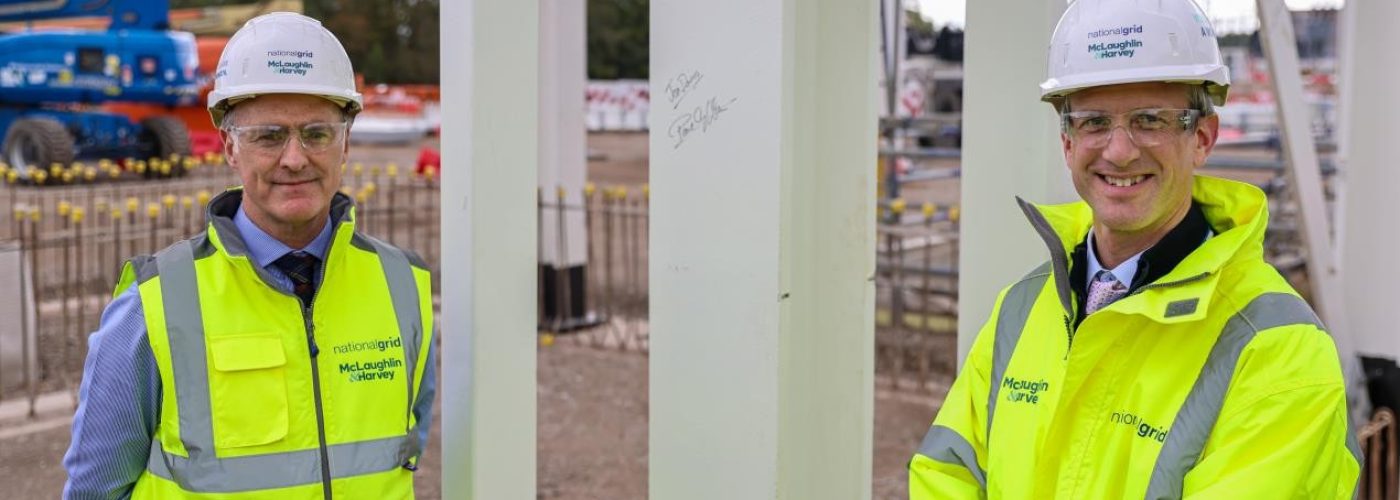McLaughlin & Harvey and National Grid celebrate steel signing milestone at the new Electricity Transmission Control Centre
National Grid has appointed McLaughlin & Harvey as main contractor to build its brand new, state-of-the-art control centre that will reinforce network resilience, uphold National Grid Electricity Transmission’s (NGET) world-class reliability standards and power the clean energy transition.
The secure, sustainable facility, called the Electricity Transmission Control Centre (ETCC), is being built on the site of National Grid’s decommissioned, former 275 kilovolt substation at Hams Hall in the Midlands.
Construction of the new control centre, which will incorporate multiple control functions into a single, collaborative space, is a key part of National Grid’s investment to increase the network’s capacity and make it easier to connect the energy needed to power the clean energy transition.
Britain’s electricity transmission system is expanding at a rapid pace to support decarbonisation and meet energy security needs. As new sources of electricity generation come online and demand patterns change, management of the growing electricity network is becoming more complex, driving the need for the modern, purpose-built new facility.
Once built and fully operational, the ETCC will work in parallel with National Grid’s existing Transmission Network Control Centre (TNCC), and will operate 24/7 365 days a year to control the operations of the high-voltage electricity transmission system.
A brownfield site, Hams Hall has powered the Midlands for a century and tells the story of Great Britain’s energy transition. Having previously housed three coal power stations it will now be home to the transmission network’s nerve centre, responsible for ensuring that clean power can travel the length and breadth of England and Wales.
The ETCC will also support National Grid in attracting and retaining the highly skilled staff needed to operate the increasingly complex network with hundreds of skilled jobs created both during construction and in engineering roles based at the facility.
On Monday, 15th September, Paul Griffen, Managing Director at McLaughlin & Harvey, joined Jon Davies, Director of Network Operations and Intelligence at National Grid, to mark the steelwork commencement milestone. To commemorate the occasion, both Paul and Jon signed a steel beam, symbolising this important step forward in the construction process.
Paul Griffen, Managing Director at McLaughlin & Harvey, said:
“It’s great to be at the site to celebrate the steel signing milestone with the project teams involved. We are committed to building this essential facility in collaboration with National Grid to enable the future energy needs of the UK to be met. Complex construction projects like this one highlight the capabilities of our talented employees to deliver outstanding results, not just in energy, but across various sectors.”
Jon Davies, Director of Network Operations and Intelligence at National Grid said:
“The development of a brand-new Electricity Transmission Control Centre marks an exciting new age for managing the complex and rapidly growing transmission network. Driven by a need to modernise and adapt to the country’s changing energy needs, the facility will futureproof our grid’s resilience and house the talented people responsible for operating our world-class transmission network for decades to come.”
McLaughlin & Harvey officially began construction in April 2025 with initial preparatory groundworks, followed by the commencement of piling in July, which saw the physical foundations of the new building being laid. The first set of steel structures for the facility are being installed in September 2025, with the new network control room expected to go-live in 2028.
Construction of the building will leave other lasting positive benefits on the local community, by redeveloping a previously unused, brownfield site, minimising embodied carbon throughout construction, enhancing biodiversity at the site by at least 10% and supporting STEM learning and development by providing education opportunities on electricity and the future energy network.
In addition, National Grid’s Community Grant Programme (CGP) will offer funds of up to £20,000 for community organisations and charities in the local area.
Building, Design & Construction Magazine | The Choice of Industry Professionals





